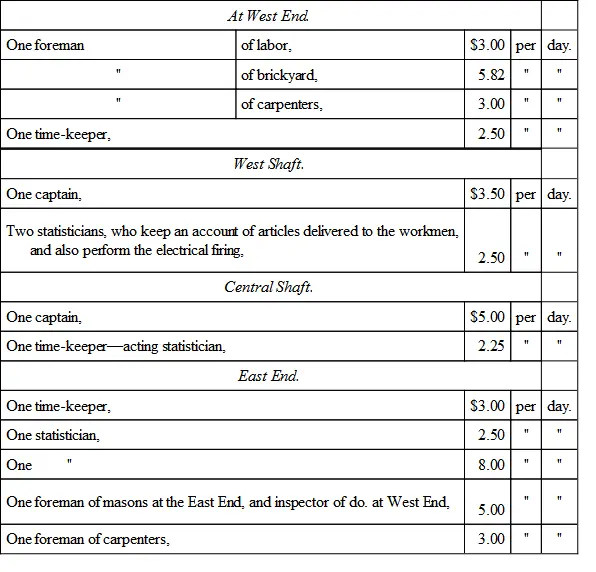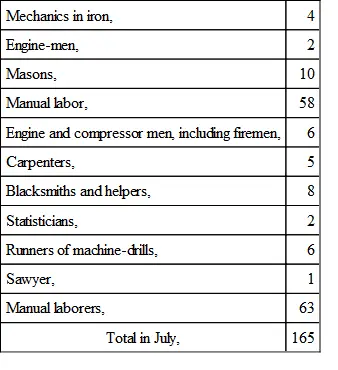Tappan Wentworth - Report of the Hoosac Tunnel and Troy and Greenfield Railroad, by the Joint Standing Committee of 1866
Здесь есть возможность читать онлайн «Tappan Wentworth - Report of the Hoosac Tunnel and Troy and Greenfield Railroad, by the Joint Standing Committee of 1866» — ознакомительный отрывок электронной книги совершенно бесплатно, а после прочтения отрывка купить полную версию. В некоторых случаях можно слушать аудио, скачать через торрент в формате fb2 и присутствует краткое содержание. Жанр: foreign_antique, Технические науки, foreign_edu, на английском языке. Описание произведения, (предисловие) а так же отзывы посетителей доступны на портале библиотеки ЛибКат.
- Название:Report of the Hoosac Tunnel and Troy and Greenfield Railroad, by the Joint Standing Committee of 1866
- Автор:
- Жанр:
- Год:неизвестен
- ISBN:нет данных
- Рейтинг книги:5 / 5. Голосов: 1
-
Избранное:Добавить в избранное
- Отзывы:
-
Ваша оценка:
- 100
- 1
- 2
- 3
- 4
- 5
Report of the Hoosac Tunnel and Troy and Greenfield Railroad, by the Joint Standing Committee of 1866: краткое содержание, описание и аннотация
Предлагаем к чтению аннотацию, описание, краткое содержание или предисловие (зависит от того, что написал сам автор книги «Report of the Hoosac Tunnel and Troy and Greenfield Railroad, by the Joint Standing Committee of 1866»). Если вы не нашли необходимую информацию о книге — напишите в комментариях, мы постараемся отыскать её.
Report of the Hoosac Tunnel and Troy and Greenfield Railroad, by the Joint Standing Committee of 1866 — читать онлайн ознакомительный отрывок
Ниже представлен текст книги, разбитый по страницам. Система сохранения места последней прочитанной страницы, позволяет с удобством читать онлайн бесплатно книгу «Report of the Hoosac Tunnel and Troy and Greenfield Railroad, by the Joint Standing Committee of 1866», без необходимости каждый раз заново искать на чём Вы остановились. Поставьте закладку, и сможете в любой момент перейти на страницу, на которой закончили чтение.
Интервал:
Закладка:

The above were contained on the engineer's pay-roll.
Since the first visit of the Committee to the tunnel, many important changes have been made in the force above mentioned, to wit: The salary of the chief engineer was reduced to $3,600, he to provide his transportation to various points upon the work. One of the assistant engineers resigned and retired, and the office of two of them has been abolished. The salary of the superintendent has been increased to $3,000. The office of freight clerk has been abolished, and its duties transferred to that of paymaster and cashier. The salaries of store-keepers and their assistants were not a charge to the State, but were paid from the profit of their respective stores.
At the commencement of the work, it was deemed necessary to provide stores at the three points where the operations were carried on, to supply the workmen readily with necessaries, so that no time might be lost by them in the important duty of making provision for their families. But in the present state of the enterprise, it is probable that private individuals would readily establish such stores, and relieve the State from a duty which, although it involved no pecuniary charge, diverted to some extent the attention of officers from their more legitimate avocations.

Of this list the foreman of the brickyard is a temporary appointment. The foreman of carpenters at the West End has finished his work and retired. The foreman of masons was discharged by the commissioners, and has entered into the employ of Mr. Farren at the West End.
There are nine foremen of the heading gangs, two of whom have $100 per month, and the remainder $3.00 per day.
The heading gangs consist of eleven drillers each, including the foreman, and from three to five rockmen for removing stone. They work by shifts of eight hours, relieving each other at 8 A. M., 4 P. M., and 12, midnight. The blasts are made about the time of relief. The men working on the enlargement under private contractors make two shifts a day, each shift working ten hours. The Committee made a special examination of the number of men employed under the engineer and superintendent, with a view of considering whether the force actually engaged was necessary to an economical prosecution of the enterprise, intending to suggest any reform that might occur to them as essential; but learning that the engineer would in the course of the year make some reduction in the number of the men as well as of the teams employed upon the work, the Committee deferred taking up the subject until the anticipated reductions should have been made. And now understanding that the commissioners have the whole matter under consideration, and that they have already to some extent, acted thereon, the Committee for reasons that would be obvious, withhold any recommendations or remarks upon this point.
System of Operations.
The general superintendence of the labor on the work is vested in Mr. Hill. The reports are made to the engineer. The captains in the tunnel report weekly the proceedings of each day under the following heads, as follows:—
Number of days' work.
of holes drilled.
of inches of holes drilled.
of drills dulled.
of pounds of powder used.
of feet of fuse used.
of sheets of paper used.
of pounds of soap used.
of pounds of candles used.
of quarts of oil used.
of lamps used.
of pounds of wicking used.
The captain at the shafts four times a month reports,—
The days' work of the engine-men.
The revolutions of the engine.
Number of pounds of coal used.
of feet of wood used.
of gallons of sperm oil used.
of gallons of kerosene oil used.
of pounds of tallow used.
of pounds of waste used.
of pounds of tar used.
of cages raised.
of cars of stone raised.
Size of pump-plunger used.
Length of stroke.
Number of strokes.
of gallons of water raised.
of boilers in use.
The materials furnished for the construction of the work are charged in their distribution to twenty-three accounts, as will be seen by the tabular statement of its cost. Requisitions for materials are signed by the immediate overseer, captain or foreman; they are handed to the superintendent for approval, and by him forwarded to the engineer. If the requisition is approved by both, the materials are ordered, and when furnished the applicant signs upon a duplicate his receipt for the same. This course is pursued as well for materials taken from the State lands as for those purchased. Suitable blanks for returns, requisitions, &c., are furnished to the several points, and the evidence of all the transactions is preserved in the office of the engineer. In addition to the above, a return of all material broken, or laid aside, is made to the engineer, at whose office a substantial account of all materials on hand, either in use, or out of use, may be found.
The organization of the working force, and the mode adopted for supplies and expenditures at the various points, appear well adapted to an efficient and economical prosecution of the enterprise.
Divisions of the Work.
East End
Deerfield Dam. —This structure is completed. Flashboards to be used in low stages of water may have to be occasionally renewed.
The canal is finished as far as wheelpit No. 3. The machine-shop is about 72 feet long, and 36 feet wide. It has three turbine wheels. A fourth wheel is designed, but is not required at the present time, and the pit to receive it is not completed.
In the basement of the machine-shop are two compressors. The first was put in January, 1866. It has four cylinders 13 inches in diameter, and 20 inches stroke. This compressor is used to drive the drills, and furnish air for the blacksmith shop. The second compressor was put in some time in October. It has four cylinders 25 inches in diameter, and 24 inches stroke, and is used for ventilation one-fourth of the time, two hours after each blast, viz., from 8 to 10, A. M., from 4 to 6, P. M., and from 12 to 2, A. M. The compressors work satisfactorily. The loss of power in the transmission of air from the machine-shop to the drills, a distance of 4,500 feet, being hardly perceptible.
In addition to the compressors, there is in the machine-shop the following machinery, viz.: three lathes, one of them worked by hand; a drilling machine; a planer; a bolt-cutting machine and a saw-table. Sixty horse-power is required to carry the machine-drills, the machines in the shop, and to furnish air for the blacksmith shop. When the large compressor is used, 75 additional horse-power is required. A circular saw at the east end of the machine shop, is occasionally used, driven by power derived from the turbine wheels.
The blacksmith shop, near the entrance of the tunnel, contains three forges. The hand-drills are made, and, together with the machine drills, sharpened at this shop. The ordinary repairs of the drilling machines are done in the machine shop. New parts of the same are furnished from Fitchburg.
The heading in the tunnel at this end when driven by hand was about 15 feet wide by 6 feet high. When driven by the machines it is 16 feet wide and 8 feet high. Its location is in the centre of the tunnel, 4 1/ 2feet above subgrade, and 1 1/ 2feet above the road bed.
The force employed at this point in July last was—

The first day of November there were employed here 115 men. There are at this point, besides the shops and saw mill above mentioned, 2 small offices, 1 boarding-house, 2 carpenters' shops, 2 powder-houses, 1 temporary blacksmith's shop, 1 temporary horse-stable, 3 sheds, 1 engine-house, 1 barn, 1 instrumental station-house (all used by the State,) and 2 cottages; 6 first-class shanties, 13 common shanties, 10 temporary shanties, 1 store under school-room; with 1 cottage, 1 old store and 8 shanties, built by H. Haupt & Company, which are rented.
Читать дальшеИнтервал:
Закладка:
Похожие книги на «Report of the Hoosac Tunnel and Troy and Greenfield Railroad, by the Joint Standing Committee of 1866»
Представляем Вашему вниманию похожие книги на «Report of the Hoosac Tunnel and Troy and Greenfield Railroad, by the Joint Standing Committee of 1866» списком для выбора. Мы отобрали схожую по названию и смыслу литературу в надежде предоставить читателям больше вариантов отыскать новые, интересные, ещё непрочитанные произведения.
Обсуждение, отзывы о книге «Report of the Hoosac Tunnel and Troy and Greenfield Railroad, by the Joint Standing Committee of 1866» и просто собственные мнения читателей. Оставьте ваши комментарии, напишите, что Вы думаете о произведении, его смысле или главных героях. Укажите что конкретно понравилось, а что нет, и почему Вы так считаете.












